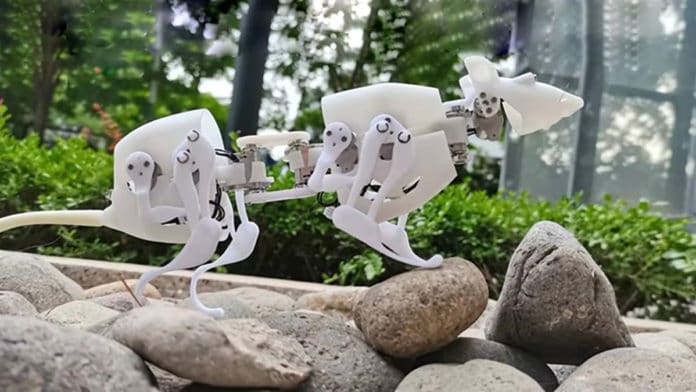Legged robots are very promising for use in real-world applications. Large quadruped robots like Spot and ANYmal have already shown excellent adaptability and load capacity, but their operation in narrow spaces is still challenging. On the other hand, micro quadruped robots could enter the narrow spaces but failed to perform tasks due to their low absolute payload capacity.
Recently, a team led by Prof. Qing Shi from the Beijing Institute of Technology, China, has developed a novel robotic rat named SQuRo (small-sized quadruped robotic rat), which is capable of mimicking the motion of actual rats inside narrow spaces.
Based on the body size and form of Norway rats (Rattus norvegicus) that live in caves, the robot has 2 degrees of freedom (DOF) in each limb to reproduce the limb movement, 2 DOFs in the waist and 2DOFs in the head to replicate the flexible spine movement. Thanks to a long and flexible spine, SQuRo can bend its body and quickly turn around.
The control framework mainly consists of three layers: a multi-motion planner with four basic motion modes and established a direct relationship between the control variable and ground reaction forces (GRFs); parameter optimization with the consideration of the stability and actuation limits; trajectory generation of each joint. The control framework makes agile movements and fast transitions possible.
On the basis of the extracted key movements joints, SQuRo was subtly designed with a relatively elongated slim body and smaller weight of just 220 grams, compared with quadruped robots of the same scale. It has an extremely small turning radius of 0.48 body length (BL) and a strong payload capacity (200 g), researchers reported in the paper. The robot can perform various motions, such as crouching-to-standing, walking, crawling, and turning, and can recover after falling by controlling its limbs and cervical parts to appropriately adjust its center of mass.
During the field tests, SQuRo successfully squeezed through irregular-shaped passages as narrow as 90 mm, walked over obstacles as tall as 30 mm, and maintained stable locomotion while climbing up a 15-degree slope. All these capabilities allow SQuRo to agilely pass through narrow spaces and rugged terrains and perform tasks, such as detection or transportation in relevant scenarios. It may one day be used for the tasks such as searching for survivors at disaster sites or performing inspections of difficult-to-reach areas.
